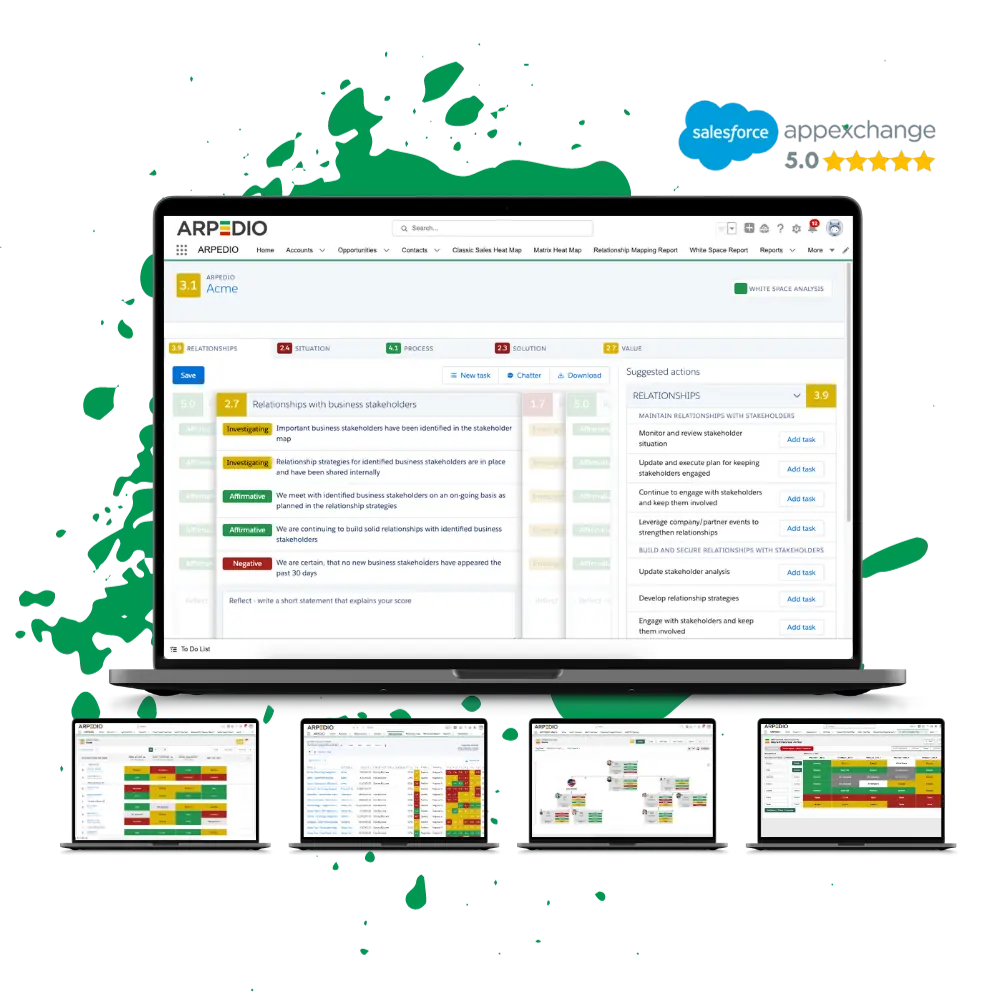In the dynamic terrain of sales, forging a path to success is an intricate dance of strategy, customer insight, and relentless pursuit of growth. Central to this quest is the art of strategic account planning, a methodical approach that marries sales strategy with customer relationship management to foster business growth. This guide is designed to shed light on the transformative power of strategic planning within sales, exemplifying how it’s not just about reaching targets but setting the bar higher for customer service and satisfaction.
Whether you’re steering a fledgling sales team or are at the helm of a seasoned squad, understanding the mechanics behind a stellar account plan is quintessential. It is the blueprint to navigate the complexities of customer engagements and the secret weapon to unlock the true potential of your accounts.
As you embark on this journey through the nuances of creating a winning plan, you’ll gain insights into personalizing client interactions, enhancing rapport, and pushing the envelope for what’s possible in your sales career. The fusion of these tactics is not just a game-changer—it’s a growth engine for the modern sales professional.
The Importance of a Strategic Account Plan in Sales
A strategic account plan stands at the core of achieving exceptional sales performance and establishing continued customer retention. In the competitive landscape of today’s market, understanding the trifecta of sales targets, business strategy, and client dynamics can propel a sales team’s success exponentially. Let us delve into the specifics that underscore the potency of a carefully crafted account strategy.
Defining Success for Sales Teams
True success in sales is measured not only by meeting or exceeding sales targets but by the sustainable growth and strategic direction that is outlined through a meticulous account plan. These plans act as blueprints, elucidating quantifiable goals and providing a clear path for sales teams to deliver on their objectives efficiently and effectively.
Enhancing Customer Relationships
Fostering strong customer relationships is the bedrock of customer retention. A strategic account plan aids in understanding the intricate needs of clients. By tailoring the sales approach to these needs, sales professionals can enhance satisfaction levels, thereby cementing long-term loyalty and repeat business.
Aligning Sales Goals with Business Objectives
Strategic account planning is a linchpin for ensuring that sales activities are not in silos but rather in harmony with the overarching business strategy. This alignment guarantees that every action taken resonates with the broader corporate objectives, thereby driving collective growth and enabling businesses to scale new heights.
| Elements of a Strategic Account Plan | Impact on Sales Performance | Contribution to Customer Retention |
|---|---|---|
| Goal Setting and Benchmarks | Directly ties sales activities to measurable outcomes | Encourages consistent service levels aligned with client expectations |
| Client Need Analysis | Enhances the relevance and precision of sales pitches | Builds trust through tailored solutions and proactive engagement |
| Strategy-Business Alignment | Ensures resources are directed towards high-value targets | Reflects an organizational commitment to quality and client success |
Embracing a strategic account plan not only sharpens the focus on mission-critical sales and retention tactics but also infuses the sales process with insights and analytics required for a competitive edge. In essence, it binds the fabric of customer-centric strategies with empirical business goals to canvas a broad stroke of enduring business success.
Remember, the warp and weft of an exceptional sales strategy are interwoven through the loom of comprehensive and strategic account planning.
Key Components of an Effective Account Plan
At the core of any successful sales strategy is the account plan, a dynamic document serving as the GPS for navigating the complexities of account management and ensuring coordinated efforts in achieving sales objectives. Incorporating comprehensive sales analysis and a targeted growth strategy, an account plan exemplifies a foundational tool for sales professionals aiming to solidify and expand their client engagements.
Account Analysis and Strategizing
Initial steps in account planning involve a deep dive into the current state of the account. This includes conducting a thorough sales analysis to evaluate historical performance, understand the buying patterns, and measure the account’s contribution to the overall revenue. With these insights, sales professionals can strategize on how to maintain and grow these relationships, focusing on areas such as product mix, purchasing trends, and customer feedback.
Account Planning Inside of Salesforce
ARPEDIO’s Account Management solution, on top of Salesforce, enhances strategic account planning and management. It provides tools for account health assessment, actionable steps to address account needs, and data-driven decision-making. The software centralizes critical account data in Salesforce, ensuring seamless team collaboration and consistency in account handling. It’s customizable to align with sales best practices and integrates AI capabilities for informed sales strategies. This solution is ideal for sales teams aiming for efficient, targeted, and data-backed account management.
Setting Clear Objectives and Milestones
Clear, actionable objectives are the milestones guiding the journey towards sales success. Each goal outlines what is to be achieved in the context of broader sales objectives, broken down into quantifiable targets. Whether it’s increasing annual spend by a percentage, boosting product penetration, or enhancing service uptake, defining these objectives provides the sales team with a clear direction and motivates focused effort.
- Establish revenue targets
- Identify product upsell opportunities
- Define customer satisfaction benchmarks
Identifying Growth Opportunities within Accounts
Building on the foundation of detailed analysis comes the identification of growth opportunities within each account. This aspect of the growth strategy revolves around pinpointing areas where additional value can be provided to the client—thus fortifying trust and reliance. Whether it’s through upselling more advanced product lines or cross-selling complementary services, each opportunity should align with the customer’s evolving needs and contribute to the strategic goals of both parties.
By synthesizing these key components, an account plan transforms from a mere document into a strategic tool, one that guides the consistent delivery of value to clients and propels the sales organization towards its objectives. Through rigorous account management practices, such plans foster informed decision-making and strategic agility, ensuring that sales teams can rapidly adapt to changes in customer preferences and market conditions.
Building a Strategic Framework for Your Account Plan
The success of any sales initiative hinges on meticulous strategic planning and the creation of a framework development that not only identifies high-value accounts but also meticulously plots the journey towards the effective sales plan execution. In this pursuit, both account targeting and ongoing adjustment to sales approaches are critical. This section will articulate the finer points of crafting a strategic framework that can be your blueprint for success.
- Identification of Key Accounts: Prioritize accounts by potential revenue, strategic importance, or alignment with business capabilities.
- Analysis of Account Needs: Dive deep into the business needs of each account, understanding their industry position, challenges, and goals.
- Strategy Formulation: Develop customized tactics for each key account that synchronizes with their requirements and your business offerings.
- Resource Allocation: Ensure adequate resources are earmarked for the most promising accounts to maximize ROI.
- Monitoring and Adaptation: Methodically track progress and remain open to adjusting strategies in response to market shifts and account feedback.
| Account Targeting Phase | Strategy Development Phase | Implementation and Monitoring Phase |
|---|---|---|
| Identify growth potential and strategic fit. | Customize a sales approach for each account. | Deploy sales strategies and record outcomes. |
| Assess competitive landscape. | Align with broader company objectives. | Adapt to feedback and market dynamics. |
| Quantify resource investment. | Set clear performance metrics. | Maintain flexibility for strategic pivots. |
Central to the framework’s development is its adaptability—a rigid plan is a brittle one. In an evolving commercial environment, the ability to fluidly adapt to market conditions and customer needs will demarcate winning sales strategies from stagnant ones. Undergirding this adaptiveness with robust, data-driven insights will galvanize your sales team’s confidence and capability in executing the sales plan proficiently.
Your strategic framework is a dynamic document; it should live and breathe the ethos of your organization while being firmly rooted in the pragmatic ground of market realities. By investing the time and energy into its careful composition, you ensure not just a plan for today, but a scalable model that can accommodate the sales successes of tomorrow as well.
Crafting Targeted Value Propositions for Key Accounts
In today’s cutthroat market, sales teams must employ a comprehensive approach to develop value propositions that directly address the nuances of each key account. This personalized strategy not only showcases a customer-centric commitment but also aligns perfectly with the unique needs and challenges that businesses face. By focusing on these specialized aspects, organizations can create a meaningful connection, shaping a value proposition that is both compelling and resonant with their audience.
Understanding Customer Needs and Challenges
Gaining an intimate understanding of your customers’ needs and the challenges they confront is the bedrock of any potent value proposition. Through rigorous competitive analysis and active listening, sales professionals can discern the intricate details of their clients’ businesses. This depth of knowledge allows for the crafting of solutions that not only meet expectations but exceed them, thereby delivering true customer-centric solutions tailored to address specific pain points.
Developing Tailored Solutions and Messaging
With a clear grasp of what drives your key accounts, the next step is to nurture this insight into tailored solutions with messaging that speaks their language. This is where the ability to customize your offerings and align them with the client’s unique objectives comes into play. By creating a narrative that reflects the client’s vision and your ability to enable it, your unique selling proposition becomes not just an offer, but a partnership they can’t afford to miss out on.
Communicating Differentiators and Competitive Advantage
The final piece of the jigsaw involves lucidly articulating your competitive advantage. It’s essential to highlight not just what you offer, but why it is superior to the competition. The ability to distinguish your solution with key differentiators that deliver real value is instrumental in solidifying your proposition. This transparency and clarity in communication are what can turn prospects into loyal customers and engender lasting brand loyalty.












